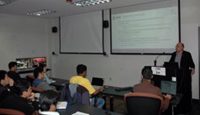TransLight/StarLight Supports International Distributed Instruction in High-Definition
February 16th, 2007
Categories: Education, Networking

About
The use of interconnected computer clusters to solve problems, also known as high-performance computing (HPC), is a leading technology of the new century. Fifteen years ago, HPC was used primarily by academics solving Grand Challenge problems and by the military; today, every person who does an Internet browser search is tapping into a supercomputing resource.
There is a rapidly growing demand for programmers who know how to do HPC, and university computer science departments worldwide are starting to augment their curricula to train their students to support commercial applications of HPC, ranging from credit card fraud detection to genome sequencing that yield new pharmaceuticals.
Louisiana State University (LSU) Center for Computation and Technology (CCT) professor Thomas Sterling, a renowned researcher in the field, is taking it a step further with his spring 2007 semester class “High-Performance Computing: Concepts, Methods and Means”. It is the first course in the US being taught using high-definition (HD) video broadcast for distributed classroom instruction.
The course is being offered to students at LSU, Louisiana Tech University, University of Arkansas, MCNC in North Carolina, and Masaryk University in the Czech Republic. NSF-funded TransLight / StarLight, an optical network link between the US and Europe in support of science and education, is being used to transmit uncompressed HD video streams to the Czech Republic. Statewide research and education optical networks Louisiana Optical Network Initiative (LONI) and the Arkansas Research and Education Optical Network (ARE-ON), and the nationwide optical network National LambdaRail, help support the course to locations in the US.
Virtual presence requires high-quality HD video and two-way audio transmission with minimum latency. A single raw HD stream consumes about 1.5 Gbps of bandwidth, and multi-site virtual meetings like this course can easily saturate a 10 Gbps link. This far exceeds the on-demand bandwidth available on the Internet, though course organizers are distributing the course via the Internet to Access Grid displays at select sites that do not yet have their optical connections and/or HD technologies in place.
Multi-gigabit optical links such as TransLight / StarLight can easily handle the transmission of such large volumes of data at low latency. In addition, computers housed at the StarLight facility in Chicago replicate the HD stream to achieve scalability. As HDTV display technology continues to drop in price, faculty and students will come to expect that the quality of equipment in their classrooms match what they have in their home.
TransLight / StarLight continues to support today’s high-performance data exchange between US scientists and their European colleagues; and, through distributed courses such as this, helps prepare tomorrow’s scientists, too.